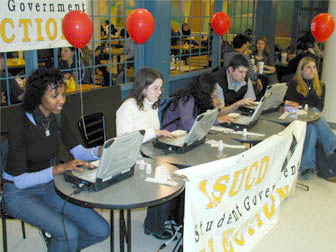|
|
No Hanging Chads Here
ASUCD Uses Web, Campus Technology to Provide Secure Online Elections, Increase Voter Turnout
The whole process, engineered by the folks at ASUCD using extensive database programming and information provided by the Registrar, went off without a hitch. 
The online voting process has also proven increasingly popular with the student body. "It's really convenient," says Jamie Williams, a Junior majoring in International Relations. "Now I don't have to try to squeeze in voting between classes." With information on the candidates and issues readily available on the voting Web site (and pictures of the candidates), students were also able to make more informed choices. "It's cool to see photos of the candidates next to their statements, and it's much more efficient and helpful than trying to keep track of them with paper," shares Melissa Christensen, a Sophomore majoring in Communications and Spanish. According to Kristen Heinen, ASCUD Election Committee Chair, the technology utilized for online voting has also made things easier for those in charge of running the elections. "The system of voting is extremely accurate and timely," says Heinen. "We get results almost immediately, and the use of very high levels of security reassures voters of the accuracy of the totals." Kerberos is Key
Upon arriving at the elections Web site, students were asked to enter their Kerberos password (the same secure technology the campus uses to protect student information). Their identities were then electronically verified with information from the Office of the Registrar, confirming voting eligibility. After voting, the student's choices were automatically tabulated and the student was removed from the eligible voting list.This type of seamless integration required some heavy-duty database programming, according to Alex Park, ASUCD Network and Database Administrator. "David Rajan, a Computer Science student, handled the bulk of the programming using advanced Oracle software," says Park. "His excellent work was fundamental in completing this project in such short order." Campus Lends a Hand
Several campus organizations also contributed to the effort, shares Park. Along with the student information provided by the Office of the Registrar, Computer Lab Management "allowed us to target people in the computer labs," says Park. "We also used the wireless access point at the Memorial Union to connect our MU laptop polling station." Online Voting: the Way of the Future?
Contrary to prevailing trends of decreasing voter turnout throughout the country, student voter participation at UC Davis has increased significantly over the past few years, coinciding directly with the efforts of ASUCD to implement online voting. According to Park, voter turnout has increased every year that online voting has been in place, with over 3800 students voting in the most recent campus election.Indeed, many students seem to believe online voting, handled properly, should be used by state and national entities. "I hadn't voted before because all the problems with paper ballots threw me off," says Tyler Hartman, a Senior majoring in German. "But here, there's no paper confusion. Those in charge of the polls in the future should take a look and head towards this style of voting." |